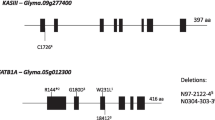Abstract
Soybean [Glycine max (L.) Merr.] oil from current commercial cultivars typically contains ca. 8% linolenic acid (18:3). Applications of plant biotechnology have enabled plant breeders to develop germplasm having as low as 2.0% 18:3. Oils that are naturally low in 18:3 exhibited improved flavor characteristics and greater oxidative stability in high-temperature frying applications compared to hydrogenated soybean oil. As an extension of that research, efforts are underway to characterize genes in soybean that govern expression of higher than normal 18:3 concentration. Such oils may be of interest to the oleochemicals industry for various nonfood applications. Relatively high 18:3 in seed oil is a characteristic trait of the ancestor of modern soybean cultivars, Glycine soja (Sieb. and Zucc.). Accessions of this species have rarely been utilized in soybean improvement, and thus represent a virtually untapped genetic resource for genes governing 18:3 synthesis. We have hybridized cultivated soybean with wild soybean plant introductions. F3:4 seed from the resultant G. max × G. soja populations exhibited a wide segregation pattern for 18:3 and seed mass. A strong negative association was found between 18:3 concentration and seed mass. Oil concentration was positively correlated with seed mass. Evaluation of glycerolipid composition revealed that high 18:3 was not associated with an altered proportion of phospholipid and triacylglycerol among lines segregating for seed mass. Thus, smaller seed mass may be a convenient trait to distinguish future soybean cultivars with highly polyunsaturated oils from other cultivars in production.
Similar content being viewed by others
References
Wilson, R.F., and J.W. Burton, Regulation of Linolenic Acid in Soybeans and Gene Transfer to High-Yielding, High-Protein Germplasm, in Proceedings of the World Conference Emerging Technologies in the Fats and Oils Industry, edited by A.R. Baldwin, American Oil Chemists’ Society, Champaign, 1986, pp. 386–391.
Fehr, W.R., G.A. Welke, E.G. Hammond, D.N. Duvick, and S.R. Cianzio, Inheritance of Reduced Linolenic Acid Content in Soybean Genotypes A16 and A17, Crop Sci. 32:903–906 (1992).
Mounts, T.L., K. Warner, G.R. List, R. Kleiman, W.R. Fehr, E.G. Hammond, and J.R. Wilcox, Effect of Altered Fatty Acid Composition on Soybean Oil Stability, J. Am. Oil Chem. Soc. 65:624–628 (1988).
Snyder, J.M., E.N. Frankel, and K. Warner, Headspace Volatile Analysis to Evaluate Oxidative and Thermal Stability of Soybean Oil. Effect of Hydrogenation and Additives, Ibid.:1055–1058 (1986).
Mounts, T.L., K. Warner, G.R. List, W.E. Neff, and R.F. Wilson, Low-Linolenic Acid Soybean Oils: Alternatives to Cooking Oils, Ibid.:495–499 (1994).
Wilson, R.F., J.W. Burton, and C.A. Brim, Progress in the Selection for Altered Fatty Acid Composition in Soybeans, Crop Sci. 21:788–791 (1981).
Burton, J.W., R.F. Wilson, and C.A. Brim, Registration of N79-2077-12 and N87-2122-4, Two Soybean Germplasm Lines with Reduced Palmitic Acid in Seed Oil, Ibid.:313 (1994).
Hammond, E.G., and W.R. Fehr, Registration of A5 Germplasm Line of Soybean, Ibid.:192 (1983).
Wilcox, J.R., and J.F. Cavins, Registration of C1640 Soybean Germplasm, Ibid.:209–210 (1986).
Burton, J.W., R.F. Wilson, C.A. Brim, and R.W. Rinne, Registration of Soybean Germplasm Lines with Modified Fatty Acid Composition of Seed Oil, Ibid.:1583 (1989).
Leffel, R.C., Registration of BARC-12, a Low Linolenic Acid Soybean Germplasm Line, Ibid.:1426–1427 (1994).
Juvik, G.A., R.L. Bernard, R. Chang, and J.F. Cavins, Evaluation of the USDA Wild Soybean Germplasm Collection: Maturity Groups 000 to IV (PI-65549 to PI-483464), U.S. Department of Agriculture, Washington, D.C., Technical Bulletin No. 1761, 1989, pp. 1–25.
Rahman, S.M, Y. Takagi, and S. Towata, Inheritance of High Linolenic Acid Content in the Soybean Mutant Line B739, Breed Sci. 44:267–270 (1994).
Rebetzke, G.J., Inheritance and Stability of Palmitic Acid Content in Soybean, Ph.D. Dissertation, Crop Science Department, North Carolina State University, Raleigh, NC, 1994.
Liu, K., F. Orthofer, and E.A. Brown, Association of Seed Size with Genotypic Variation in the Chemical Constituents of Soybeans, J. Am. Oil Chem. Soc. 72:189–192 (1995).
United States Department of Agriculture, Agricultural Research Service, National Plant Germplasm System, available @ http://www.ars-grin.gov/npgs, Washington, D.C.
SAS User’s Guide: Statistics, Version 5 Edition, SAS Institute, Inc., Cary, NC, 1985.
Wilson, R.F., Seed Metabolism, in Soybeans: Improvement, Production and Uses, 2nd edn., Agronomy Monograph 16, edited by J.R. Wilcox, ASA, Madison, WI, 1987, pp. 643–686.
Rennie, B.D., and J.W. Tanner, Fatty Acid Composition of Oil from Soybean Seeds Grown at Extreme Temperatures, J. Am. Oil Chem. Soc. 66:1622–1624 (1989).
Wilcox, J.R., and J.F. Cavins, Normal and Low Linolenic Acid Soybean Strains: Response to Planting Date, Crop Sci. 32:1248–1251 (1992).
Rebetzke, G.J., V.R. Pantalone, J.W. Burton, T.E. Carter Jr, and R.F. Wilson, Genotypic Variation for Fatty Acid Content in Selected Glycine max. × Glycine soja Populations (Glycine soja L.), Ibid. 37(5):in press.
Appelqvist, L.A., The Chemical Nature of Vegetable Oils, in Oil Crops of the World, Their Breeding and Utilization, edited by G. Robbelen, R.K. Downey, and A. Ashri, McGraw-Hill, New York, 1989, pp. 22–37.
Burton, J.W., Quantitative Genetics: Results Relevant to Soybean Breeding, in Soybeans: Improvement, Production and Uses, 2nd edn., Agronomy Monograph 16, edited by J.R. Wilcox, ASA, Madison, WI, 1987, pp. 211–247.
Carter, T.E. Jr., E.B. Huie, J.W. Burton, F.S. Farmer, and Z. Gizlice, Registration of “Pearl” Soybean, Crop Sci. 35:1713 (1995).
Author information
Authors and Affiliations
About this article
Cite this article
Pantalone, V.R., Rebetzke, G.J., Wilson, R.F. et al. Relationship between seed mass and linolenic acid in progeny of crosses between cultivated and wild soybean. J Amer Oil Chem Soc 74, 563–568 (1997). https://doi.org/10.1007/s11746-997-0181-2
Received:
Accepted:
Issue Date:
DOI: https://doi.org/10.1007/s11746-997-0181-2




